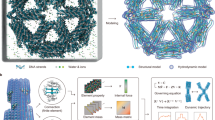Abstract
This paper deals with the problem of designing the secondary structure of a multi-state molecular machine in which the formation of repeated DNA hairpin structures changes sequentially with the aim of implementing more sophisticated DNA nanomachines. Existing methods are insufficient to construct such a huge molecular machine using multiple DNA molecules. The method used in this paper validates the changes in formation exhaustively by dividing the secondary structure into hairpin units. It considers the minimum free energy of the structure, the structure transition paths, and the total frequency of optimal and sub-optimal structures. Hence, it can better design base sequences using the principles of thermodynamics.
Access this chapter
Tax calculation will be finalised at checkout
Purchases are for personal use only
Preview
Unable to display preview. Download preview PDF.
Similar content being viewed by others
References
Allawi, H.T., et al.: Thermodynamics and NMR of internal GT mismatches in DNA. Biochemistry 36, 10581–10594 (1997)
Allawi, H.T., et al.: Nearest neighbor thermodynamic parameters for internal GA mismatches in DNA. Biochemistry 37, 2170–2179 (1998)
Allawi, H.T., et al.: Thermodynamics of internal CT mismatches in DNA. Nucleic Acids Research 26, 2694–2701 (1998)
Allawi, H.T., et al.: Nearest-neighbor thermodynamics of internal AC mismatches in DNA: Sequence dependence and pH effects. Biochemistry 37, 9435–9444 (1998)
Bommarito, S., et al.: Thermodynamic parameters for DNA sequences with dangling ends. Nucleic Acids Research 28, 1929–1934 (2000)
Flamm, C., et al.: RNA folding at elementary step resolution. RNA 6, 325–338 (2000)
Hofacker, I.L., et al.: Fast folding and comparison of RNA secondary structures. Monatshefte für Chemie (Chemical Monthly) 125, 167–188 (1994)
Kameda, A., et al.: Conformational addressing using the hairpin structure of single-stranded DNA. In: Chen, J., Reif, J.H. (eds.) DNA 2003. LNCS, vol. 2943, pp. 219–224. Springer, Heidelberg (2004)
Mao, C., et al.: A nanomechanical device based on the B-Z transition of DNA. Nature 397, 144–146 (1999)
McCaskill, J.S.: The equilibrium partition function and base pair binding probabilities for RNA secondary structure. Biopolymers 29, 1105–1119 (1990)
Morgan, S.R., et al.: Barrier heights between ground states in a model of RNA secondary structure. J. Phys. A: Math. Gen. 31, 3153–3170 (1998)
Peyret, N., et al.: Nearest neighbor thermodynamics of DNA with AA, CC, GG and TT mismatches. Biochemistry 38, 3468–3477 (1999)
SantaLucia Jr., J.: A unified view of polymer, dumbbell, and oligonucleotide DNA nearest-neighbor thermodynamics. Proc. Natl. Acad. Sci. USA 95, 1460–1465 (1998)
Simmel, F.C., et al.: Using DNA to construct and power a nanoactuator. Physical Review E 63, 041913 (2001)
Simmel, F.C., et al.: A DNA-based molecular device switchable between three distinct mechanical states. Applied Physics Letters 80, 883–885 (2002)
Turberfield, A.J., et al.: DNA fuel for free-running nanomachines. Physical Review Letters 90(11), 118102 (2003)
Uejima, H., et al.: Analyzing the secondary structure transition paths of DNA/RNA molecules. In: Chen, J., Reif, J.H. (eds.) DNA 2003. LNCS, vol. 2943, pp. 86–90. Springer, Heidelberg (2004)
Wuchty, S., et al.: Complete suboptimal folding of RNA and the stability of secondary structures. Biopolymers 49, 145–165 (1999)
Yan, H., et al.: A robust DNA mechanical device controlled by hybridization topology. Nature 145, 62–65 (2002)
Yurke, B., et al.: A DNA-fuelled molecular machine made of DNA. Nature 406, 605–608 (2000)
Zuker, M., et al.: Optimal computer folding of large RNA sequences using thermodynamics and auxiliary information. Nucleic Acids Research 9, 133–148 (1981)
Author information
Authors and Affiliations
Editor information
Editors and Affiliations
Rights and permissions
Copyright information
© 2004 Springer-Verlag Berlin Heidelberg
About this paper
Cite this paper
Uejima, H., Hagiya, M. (2004). Secondary Structure Design of Multi-state DNA Machines Based on Sequential Structure Transitions. In: Chen, J., Reif, J. (eds) DNA Computing. DNA 2003. Lecture Notes in Computer Science, vol 2943. Springer, Berlin, Heidelberg. https://doi.org/10.1007/978-3-540-24628-2_9
Download citation
DOI: https://doi.org/10.1007/978-3-540-24628-2_9
Publisher Name: Springer, Berlin, Heidelberg
Print ISBN: 978-3-540-20930-0
Online ISBN: 978-3-540-24628-2
eBook Packages: Springer Book Archive




